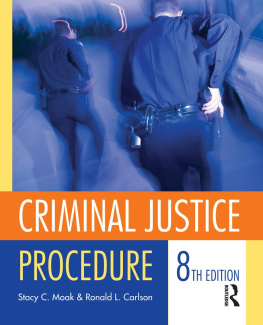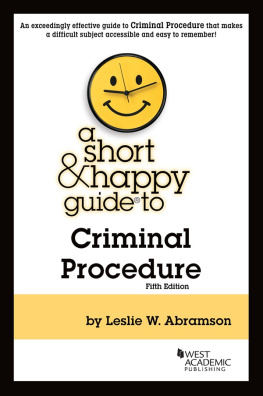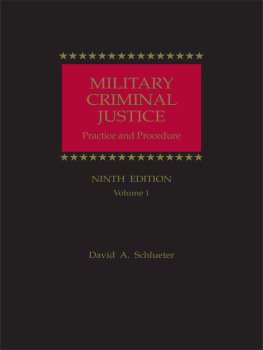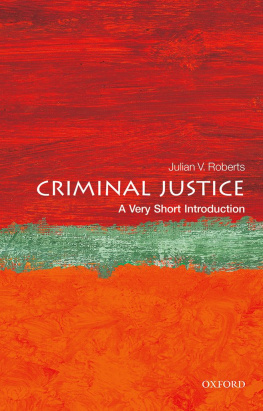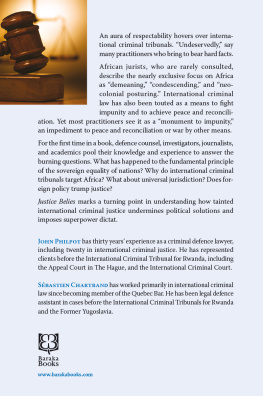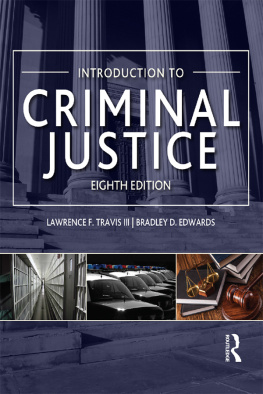Stacy C. Moak - Criminal Justice Procedure
Here you can read online Stacy C. Moak - Criminal Justice Procedure full text of the book (entire story) in english for free. Download pdf and epub, get meaning, cover and reviews about this ebook. year: 2015, publisher: Taylor & Francis, genre: Romance novel. Description of the work, (preface) as well as reviews are available. Best literature library LitArk.com created for fans of good reading and offers a wide selection of genres:
Romance novel
Science fiction
Adventure
Detective
Science
History
Home and family
Prose
Art
Politics
Computer
Non-fiction
Religion
Business
Children
Humor
Choose a favorite category and find really read worthwhile books. Enjoy immersion in the world of imagination, feel the emotions of the characters or learn something new for yourself, make an fascinating discovery.
- Book:Criminal Justice Procedure
- Author:
- Publisher:Taylor & Francis
- Genre:
- Year:2015
- Rating:5 / 5
- Favourites:Add to favourites
- Your mark:
- 100
- 1
- 2
- 3
- 4
- 5
Criminal Justice Procedure: summary, description and annotation
We offer to read an annotation, description, summary or preface (depends on what the author of the book "Criminal Justice Procedure" wrote himself). If you haven't found the necessary information about the book — write in the comments, we will try to find it.
Criminal Justice Procedure — read online for free the complete book (whole text) full work
Below is the text of the book, divided by pages. System saving the place of the last page read, allows you to conveniently read the book "Criminal Justice Procedure" online for free, without having to search again every time where you left off. Put a bookmark, and you can go to the page where you finished reading at any time.
Font size:
Interval:
Bookmark:
Ronald L. Carlson

2 Park Square, Milton Park, Abingdon, Oxon OX14 4RN
711 Third Avenue, New York, NY 10017, USA
No part of this book may be reprinted or reproduced or utilised in any form or by any electronic, mechanical, or other means, now known or hereafter invented, including photocopying and recording, or in any infor mation storage or retrieval system, without permission in writting from the publishers.
No responsibility is assumed by the publisher for any injury and/or damage to persons or property as a matter of products liability, negligence or otherwise, or from any use of operation of any methods, products, instructions or ideas contained in the material herein.
should
be mindful of their own safety and the safety of others, including parties for whom they have a professional responsibility.
Application submitted
A catalogue record for this book is available from the British Library.
Professor and Graduate Coordinator
Little Rock, Arkansas
July 2012
- Test Bank Compose, customize, and deliver exams using an online assessment package in a free Windows-based authoring tool that makes it easy to build tests using the unique multiple choice and true-or-false questions created for Civil Liability in Criminal Justice. What's more, this authoring tool allows you to export customized exams directly to Blackboard, WebCT, eCollege, Angel, and other leading systems. All test bank files are also conveniently offered in Word format.
- PowerPoint Lecture Slides Reinforce key topics with focused PowerPoint slides, which provide a perfect visual oudine with which to augment your lecture. Each individual book chapter has its own dedicated slideshow.
- Lesson Plans Design your course around customized lesson plans. Each individual lesson plan acts as a separate syllabus containing content synopses, key terms, content synopses, directions to supplementary websites, and more open-ended critical thinking questions designed to spur class discussion. These lesson plans also delineate and connect chapter-based learning objectives to specific teaching resources, making it easy to catalogue the resources at your disposal.
- Self-Assessment Question Bank Enhance review and study sessions with the help of this online self-quizzing asset. Each question is presented in an interactive format that allows for immediate feedback.
- Case Studies Apply what is on the page to the world beyond with the help of topic-specific case studies, each designed to turn theory into practice and followed by three interactive scenario-based questions that allow for immediate feedback.
Font size:
Interval:
Bookmark:
Similar books «Criminal Justice Procedure»
Look at similar books to Criminal Justice Procedure. We have selected literature similar in name and meaning in the hope of providing readers with more options to find new, interesting, not yet read works.
Discussion, reviews of the book Criminal Justice Procedure and just readers' own opinions. Leave your comments, write what you think about the work, its meaning or the main characters. Specify what exactly you liked and what you didn't like, and why you think so.

